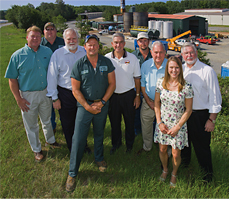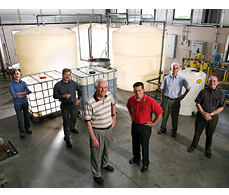




Brad Hayes (far left), chemist and quality control manager, left a good job with Brown-Williamson Tobacco Company to work for Wayne Johnson (far right), president and CEO of Macon-based Alterra Bioenergy, and Harry Cummins, III (third from left), executive vice-president. Engineer and vice-president, Lisa Ryan (second from right) left a well-paying job at Coca Cola Company in Atlanta to work for Alterra. Mayor Ken Turner (center), recruited the plant to Gordon, Georgia, where until recently, kaolin was the area’s primary industry. Others in the photo include: Frank Wall (third from right), chair, Wilkinson Development Authority; Tim Spivey (fourth from left), plant manager, Travis Spivey (second from left) and David Deese (fourth from right), who also left managerial positions to work at the new plant. Johnson, who is building a second plant in Plains, says Alterra’s Gordon plant “probably wouldn’t be here if it weren’t for UGA.”
![]()

The engineers—working on biofuels before it was cool. They’ve been researching the logistics of turning biomass into transportation fuels and other biological products for more than 30 years.
![]()
Breathing New Life into Rural Economies
Last February, the promise of biomass-to-energy prompted an elite group of scientists, agriculture officials, business leaders, and others—dubbed the 25x’25 National Steering Committee—to predict that “America’s farms, ranches, and forests will provide 25 percent of the total energy consumed in the United States” by 2025. The committee’s report outlined numerous benefits for the nation including:
- Generating $700 billion in new economic activity annually
- Creating 4 million to 5 million new jobs
- Reducing overall oil consumption by 2.5 million barrels per day—10 percent of total projected U.S. oil use in 2025
- Reducing carbon-dioxide emissions by 1 million tons—two-thirds of projected emissions growth by 2025.
 “These are noble and achievable goals,” says UGA’s Threadgill, a National Steering Committee member. “And we can do it while continuing to produce safe, abundant, and affordable food, feed, and fiber.”
“These are noble and achievable goals,” says UGA’s Threadgill, a National Steering Committee member. “And we can do it while continuing to produce safe, abundant, and affordable food, feed, and fiber.”
Georgia and the rest of the South, with vast farmlands and forestlands, are expected to reap huge benefits from all of this. “It will breathe new life into rural economies, many of which are dying on the vine,” says Tom Adams, who oversees UGA’s engineering outreach efforts.
To a certain extent, biofuels are already helping revive rural economies in Georgia. At least 10 biodiesel plants and eight ethanol production facilities are in production, under construction, or planned for the state
One of the new biodiesel plants is located in Gordon, a town in Middle Georgia’s rural Wilkinson County. Built by Macon-based Alterra Bioenergy, the plant will initially produce 15 million gallons of biodiesel per year, eventually doubling that output. The feedstock will be soybean oil, most of it coming from Georgia farmers. Alterra president Wayne Johnson notes that he relied heavily on the expertise of UGA engineers to help design the plant and provide technological know-how. “We probably wouldn’t be here if it weren’t for UGA,” says Johnson, whose company is also building another biodiesel plant in Plains and hopes to open other facilities around the state.
In Gordon, Mayor Ken Turner is ecstatic about Alterra’s plant—and the jobs it will bring to this economically depressed area. He is also proud of the town’s efforts on its own behalf. “We went out and courted them to come here,” says Turner.
Corn is Not the Answer
Alterra will make biodiesel through a well-known process called “transesterification,” in which vegetable oils are mixed with methanol and a catalyst and then heated. But a big challenge facing biodiesel producers is feedstock. Most oils that are potential biodiesel raw material are also used in food and have associated high prices. And while there other potential feedstocks—chicken fat, for instance—that are currently plentiful and inexpensive, higher demand could drive their prices up too. Some feedstocks might also need more processing to be rendered into biodiesel. Chicken fat in particular has a high fatty acid content, which makes extra preparation necessary.
UGA researchers are working to find solutions to these problems, such as developing copious oil-producing crops. An example is canola, which would grow abundantly as a rotation crop in Georgia’s mild winters.
For ethanol, the picture is more muddled. In his State of the Union address last January, President Bush called for the annual production of 35 billion gallons of alternative fuel—mostly ethanol—by 2017. The Senate, in the energy bill passed in June, set a 36 billion-gallon target by 2022. These are staggering goals, given that the nation would have to increase its present ethanol output sevenfold.
Nationwide, more than 121 ethanol biorefineries are operating, and another 75 are under construction, according to the Renewable Fuels Association. All of these plants on line, it estimates, would produce 12.6 billion gallons of ethanol a year, far short of the above goals. Moreover, nearly all of the ethanol plants are designed to use corn as the feedstock—the Southeast’s biggest corn-to-energy plant is under construction in Camilla, Ga.—and the cost of making ethanol this way may be more than the nation can bear. One reason is that only about 20 percent of each gallon is “new” energy. A lot of petroleum diesel is currently needed to operate tractors, harvesters, and irrigation equipment; and natural gas is used to make fertilizer and run the biorefineries. In addition, growing and processing corn requires a lot of water, the use of which is becoming a bone of contention in many states faced with water shortages.
Finally, as more corn is used to make ethanol, less of it is available for the production of food and livestock feed, thus driving up their prices. In May, Iowa State University researchers estimated that U.S. consumers will pay $47 more per person per year for food as a result of higher corn prices—a nationwide increase of about $14 billion.
These issues lead UGA’s Threadgill to declare: “The future growth in biofuels won’t be in corn ethanol.”
For comments or for information please e-mail: rcomm@uga.edu
To contact the webmaster please email: ovprweb@uga.edu
![]()